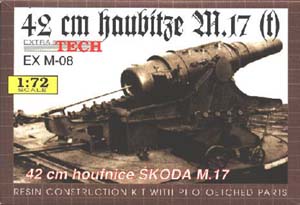Extratech resin 1/72 42cm Haubitze M.17(t) By Grzegorz Mazurowski |  | The gun If any WWI weapon deserves to be compared with the nuclear bomb, it is the Austro-Hungarian Skoda 420mm howitzer, the most advanced and extremely effective artillery piece used in the Great War. In comparison with the similar German 420mm "Gamma Morser" (so called "Dicke Berta" or "Fat Berta") it was lighter, more mobile, and was able to shoot the heavier shell on the greater distance! "420" was born shortly before the war in Plzno (Pilsen - yes! The Czech beer town!) as anti-shipping shore artillery, designed to defend the Austro-Hungarian bases located at the Dalmatian shore of the Adriatic. It was intended to be able to destroy even the largest enemy ship with the single hit. Its official designation was: "42cm L/15 Kuestenhaubitze", later changed on the "42cm Haubitze M.14". And then the war begun. Heavy artillery became a key weapon in destroying the Belgian and French forts on the Western front. Germany, with all their excellent artillery, were unable to do it alone, so some Austro-Hungarian batteries armed with the excellent Skoda 305mm guns were relocated to the western German border. French and Belgian forts had no chance. Success was so great that Karl Skoda was invited by the German High Command to visit the captured forts and to see the damage caused by his "kids". Simultaneously it was decided that the even more powerful guns will be given to the k.u.k. Army. 420mm howitzer was removed from the concrete emplacement and "mobilized" - put on the twelve-car railroad train, and moved to the Eastern Front. Operational weight of the gun was over 200 tons! Its first action was a great success, and also a milestone in the history of warfare: it was the 1914 December bombardment of the town of Tarnow, occupied by Russians. For the first time in the history the artillery spotter was located in the wireless equipped airplane! Heavy shells did a lot of damage to the Russian forces and the railroad station, while the Polish citizens of the town were safe, loudly cheering every incoming shell. As the naval gun proved to be very effective as an Army weapon, Skoda got the order for the modified, lighter and more mobile versions of the "420". They were designated "42cm Autohaubitze M.16" and "M.17", weighted a little bit over 100 tons, and were transported by the "road trains" towed by the Porsche tractors, which were able to carry the heavy gun even on the narrow and steep roads on the Italian Front in the Alps, where these guns were successfully used. In the 1939 one of these guns was captured by the German forces occupying Czechoslovakia, and after some minor modifications entered the service in Wehrmacht. It was used in the 1940 campaign against the French forts of the Maginot Line, and later in siege of the Russian fortress in Sevastopol (now Ukraine). Wehrmacht designation of this gun was "42cm Haubitze M.17(t)". The kit The Extratech kit represents WWII version of that famous gun. The box contains eight resin parts (including one shell) and two PE frets, bigger one depicting the base of the gun, and the smaller contains the details. Resin parts are very well cast, and there are no visible moulding faults. Level of detail is well, although some parts (especially the rivets) are depicted too modestly - at least some of them should be much bigger. The soldier visible on the scan isn't a part of the kit (it comes from the Revell 1/72 "Afrika Korps" set, but looks very much like WWI Austrian) - I' ve included it for size comparison. Conclusion The kit is very easy to build, and the modeler who already did something with even the most basic resin and PE parts shouldn't face any problem building it. There is one thing that the modeler will need to add: some strong and stiff base for the whole kit, which, without that addition, will have to sit on the very thin and delicate PE brass sheet. But if you like the problems, or you simply are the WWI enthusiast, you can manage to make some more: to convert this kit into the original, WWI Austro-Hungarian version. It shouldn't be difficult, the most important thing you have to change is the big cover of the barrel angle regulation device - it should be more rounded. Another conversion is also possible: into the naval, shore version of the gun, in the round turret. But this is the more complex task, as you will have to scratchbuild the turret, and the documentation for this conversion is very hard to find. I recommend this kit very highly! | 








|
